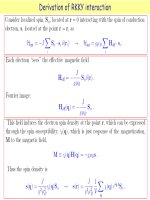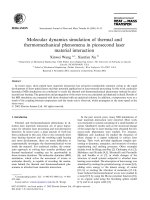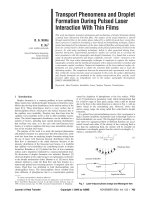Gauche interaction
Bạn đang xem bản rút gọn của tài liệu. Xem và tải ngay bản đầy đủ của tài liệu tại đây (213.75 KB, 16 trang )
Conformational Analysis
Dale L. Boger
I. Conformational Analysis
A. Acyclic sp3-sp3 Systems: Ethane, Propane, Butane
staggered
eclipsed
H
1. Ethane
H
H
H
H
H
1.0 kcal
H
H
60° rotation
HH
H
H
H
HH
H
H
H
E
3
rel. E
2
(kcal)
1
E
3.0 kcal
S
0
H
H
H
E
60
S
120
60° rotation
180
S
240
300
360
dihedral angle
H
H
H
- Two extreme conformations, barrier to rotation is 3.0 kcal/mol.
eclipsed
H
2. Propane
H
CH3
H
H
H
H
CH3
HH
1.3 kcal
60° rotation H
HH
H
fully eclipsed
(synperiplanar)
E
3.3 kcal
S
S
60
120
180
S
240
300
360
dihedral angle
H
- Barrier to rotation is 3.3 kcal/mol.
- Note: H/H (1.0 kcal) and Me/H (1.3 kcal) eclipsing interactions are
comparable and this is important in our discussions of torsional strain.
gauche
(synclinal)
H
H3C
CH3
E
CH3 60° rotation
1.0 kcal each
H3C
E
0
H
H
3. Butane
4
rel. E 3
(kcal) 2
1
staggered
H
H
CH3
H
H
H
H3C
CH3
staggered
(antiperiplanar)
H3C
H
H
H
H
H
CH3
H
H CH3
gauche
interaction
4.0 kcal
1.3 kcal each
0.9 kcal
H3C
H3C
CH3
CH3
H
CH3
60° rotation H
60° rotation H
CH3 60° rotation
H
H
HH
HH
HH
H
H
CH3
H
H
H
CH3
H
H
H
H
eclipsed
(anticlinal)
H
H
H
H
1.0 kcal each
6
5
4
rel. E
(kcal) 3
2
1
1.0 kcal
FE
FE
E
E
- Note: the gauche butane
interaction and its magnitude
(0.9 kcal) are very important
and we will discuss it frequently.
6.0
kcal
G
3.6 kcal
0.9 kcal
0
60
120
G
S
180
240
300
360
dihedral angle
1
Modern Organic Chemistry
The Scripps Research Institute
4. Substituted Ethanes
- There are some exceptions to the lowest energy conformation. Sometimes, a gauche
conformation is preferred over staggered if X,Y are electronegative substituents.
cf: Kingsbury J. Chem. Ed. 1979, 56, 431.
X
H
X
Y
H
H
H
H
Y
X
H
H
H
H
H
H
H
Y
gauche
H
X
H
H
Y
H
staggered
Egauche < Estaggered if X = OH, OAc and Y = Cl, F
- However, additional substitution more heavily populates staggered conformation; i.e.,
substitution can increase the rate of epoxide formation.
5. Rotational Barriers
H
H
H
H
H
H
H
H
H
CH3
H
H
H
H
H
2.88 kcal/mol
(3.0 kcal/mol
3.40 kcal/mol
3.3 kcal/mol
H
CH3
H3C
H
H
CH3
CH3
H
CH3
3.90 kcal/mol
3.6 kcal/mol
4.70 kcal/mol
3.9 kcal/mol)
- Experimental
- Simple prediction
- The rotational barrier increases with the number of CH3/H eclipsing interactions.
H
H
H
H
H
H
H
2.88 kcal/mol
(3.0 kcal/mol
H
H
H
H
H
N
••
1.98 kcal/mol
2.0 kcal/mol
••
H
H
O
••
H
- Experimental
- Simple prediction
1.07 kcal/mol
1.0 kcal/mol)
- The rotational barrier increases with the number of H/H eclipsing interactions.
B. Cyclohexane and Substituted Cyclohexanes, A Values (∆G°)
1. Cyclohexane
4
Hax
1
Heq
3 2
chair
5 6
4
6
5
3
Ea = 10 kcal
Heq
1
Hax
chair
2
4 atoms in plane
H
HH
H
H
H
H
HH
H
H
half chair
(rel E = 10 kcal)
2
H
H
H
H
H
H
twist boat
(rel E = 5.3 kcal)
H
HH
HH
H
H
half chair
(rel E = 10 kcal)
Conformational Analysis
Dale L. Boger
- Chair conformation (all bonds staggered)
Hax Hax Hax
Heq
Heq
Heq
Heq
Hax Hax Hax
- Rapid interconversion at 25 °C (Ea = 10 kcal/mol, 20 kcal/mol available at 25 °C).
- Hax and Heq are indistinguishable by 1H NMR at 25 °C.
- At temperatures < -70 °C, Heq and Hax become distinct in 1H NMR.
- Boat conformation
2.9 kcal
flagpole interaction
H Hax
H
Heq
H
H
H
H
H
Hax
H
Hax
H
Heq
1.0 kcal
each (4x)
- Rel E = 6.9 kcal, not local minimum on energy surface
- More stable boat can be obtained by twisting (relieves
flagpole interaction somewhat)
- Twist boat conformation (rel E = 5.3 kcal) does represent
an energy minimum, so it is slightly populated at 25 °C
- The boat conformation becomes realistic if flagpole
interactions are removed, i.e.
O
X
- Half chair conformation
H
HH
D.H.R. Barton received the 1969
Nobel Prize in Chemistry for his
contributions to conformational
analysis, especially as it relates to
steroids and six-membered rings.
Barton Experientia 1950, 6, 316.
H
H
HH
H
- Energy maximum (rel E = 10.0 kcal)
10
half
chair
half
chair
rel E
(kcal)
5
10 kcal
twist boat
5.3 kcal
0
chair
chair
3
Modern Organic Chemistry
The Scripps Research Institute
2. Substituted Cyclohexanes
- Methylcyclohexane
H
H
CH3
H
∆G° = -RT(ln K)
1.8 x 1000
1.99 x 298 = -ln K
CH3
H
1.8 kcal more stable
- The gauche butane interaction is most often identifiable as 1,3-diaxial interactions.
H
H
CH3
H
H
H
H
H
H
H
H
H
H
H
CH3
H
H
2 gauche butane interactions
2 x 0.9 kcal = 1.8 kcal
(experimental 1.8 kcal)
H
H
H
0 gauche butane interactions
- A Value (-∆G°) = Free energy difference between equatorial and axial
substituent on a cyclohexane ring
Typical A Values
R
F
Cl
Br
I
OH
OCH3
OCOCH3
NH2
NR2
CO2H
CO2Na
CO2Et
SO2Ph
A Value (kcal/mol)
0.25
0.52
0.5-0.6
0.46
0.7 (0.9)
0.75
0.71
1.8 (1.4)
2.1
1.2 (1.4)
2.3
1.1
2.5
R
CN
C CH
ca. 0.5 kcal
ca. 0.7 kcal
(2nd atom effect
very small)
NO2
CH=CH2
CH3
CH2CH3
nC H
3 7
nC H
4 9
CH(CH3)2
C(CH3)3
C6H5
- Note on difference between iPr and tBu A values
H
CH3
CH3
H3C
H
H
CH3
CH3
H
H
4
iPr
group can position
a H toward "inside,"
but tBu group cannot.
Very serious interaction, 7.2 kcal.
A Value (kcal/mol)
Small, linear
0.2
groups
0.41
1.1
1.7
1.8
2nd atom
1.9 (1.8)
effect very
2.1
small
2.1
2.1
>4.5 (ca. 5.4)
3.1 (2.9)
Conformational Analysis
Dale L. Boger
- Determination of A value for tBu group
0.9 kcal
CH3
7.2 kcal H3C
H
H
CH3
H
H
∆G° = (9.0 kcal - 3.6 kcal)
= 5.4 kcal
H
H
CH3
H
CH3
H
CH3
0.9 kcal
0.9 kcal each
7.2 kcal + (2 x 0.9 kcal) = 9.0 kcal
4 x 0.9 kcal = 3.6 kcal
- Note on interconversion between axial and equatorial positions
H
Cl
H
Cl
t1/2 = 22 years at -160 °C
Even though Cl has a small A value (i.e. small ∆G° between rings
with equatorial and axial Cl group), the Eact (energy of activation)
is high (it must go through half chair conformation)
trans-1,2-dimethylcyclohexane
H
H
CH3
H
H
H
H
2.7 kcal/mol more stable
H
H
H
CH3
H
H
H
H
CH3
CH3
H
CH3
H
cis-1,2-dimethylcyclohexane
H
H
H
H
CH3
4 x (gauche interaction)
4 x (0.9 kcal) = 3.6 kcal
H
H
H
H
H
H
H
CH2
H
CH3
∆E = 0 kcal/mol
H
H
CH3
H
CH3
H
1 x (gauche interaction)
1 x (0.9 kcal) = 0.9 kcal
H
CH3 H
CH2
H
H
H
CH3
CH3
H
CH2
H
H
3 x (gauche interaction)
3 x (0.9 kcal) = 2.7 kcal
H2/Pt
CH3
H
H
H
H
H
H
H
H
CH2
CH3 H
3 x (gauche interaction)
3 x (0.9 kcal) = 2.7 kcal
CH3
CH3
∆G = 1.87 kcal/mol (exp)
∆G = 1.80 kcal/mol (calcd)
5
Modern Organic Chemistry
The Scripps Research Institute
trans-1,3-dimethylcyclohexane
H
H
CH3
H
CH3
CH3
H
H
CH3 H
H
cis-1,3-dimethylcyclohexane
H
CH3
H
CH3
H
H
H
CH3
CH3 H
H
H
H
H
H
CH3
H
H
CH3
CH3
H
H
H
H
H
H
H
H
H
2 x (gauche interaction)
2 x (0.9 kcal) = 1.8 kcal
CH3 H
CH3
CH3
CH3
H
H
2 x (gauche interaction)
2 x (0.9 kcal) = 1.8 kcal
CH3
H
H
H2/Pt
H
CH3
H
H
2 x (gauche interaction) +
1 x (Me-Me 1,3 diaxial int)
2 x (0.9 kcal) + 3.7 kcal
= 5.5 kcal
H
H
H
0 x (gauche interaction)
0 x (0.9 kcal) = 0 kcal
CH3
CH3
CH3
∆G = 1.80 kcal/mol (exp and calcd)
- Determination of energy value of Me-Me 1,3-diaxial interaction
CH3
CH3
CH3
H
CH3
CH3
CH3
3 x Me-Me 1,3-diaxial
interaction
H
CH3
H2/Pt
CH3
H
2 x (gauche interaction)
2 x (0.9 kcal) = 1.8 kcal
500 °C
CH3
H
CH3
CH3
H
H
CH3
CH3
CH3
CH3
H
2 x (gauche interaction) + 2 x (gauche interaction) +
1 x (Me-Me 1,3 diaxial int) = 1 x (Me-Me 1,3 diaxial int) =
2 x (0.9 kcal) + ?
2 x (0.9 kcal) + ?
∆G = 3.7 kcal/mol (exp)
So, Me-Me 1,3-diaxial interaction = 3.7 kcal/mol
1,3-diaxial interactions
R/R
OH/OH
OAc/OAc
OH/CH3
CH3/CH3
∆G°
1.9 kcal
2.0 kcal
2.4 (1.6) kcal
3.7 kcal
∆G° of common interactions
ax H
ax OH
eq OH
eq CH3
ax OH
ax CH3
eq OH
0.45*
1.9
0.35
0.35
0.9
1.6
0.35
0.9
0.0
0.35
0.35
0.35
*1/2 of A value
6
CH3
Conformational Analysis
Dale L. Boger
C. Cyclohexene
One 1,3-diaxial interaction removed
One 1,3-diaxial interaction reduced
pseudoequatorial
pseudoaxial
- half-chair
- Eact for ring interconversion = 5.3 kcal/mol
- the preference for equatorial orientation of a
methyl group in cyclohexene is less than in
cyclohexane because of the ring distortion and the
removal of one 1,3-diaxial interaction (1 kcal/mol)
D. Decalins
trans-decalin
cis-decalin
H
HH
H
H
H
H
H
two conformations equivalent
H
H
H
H
H
H
H
H
H
H
H
H
H
H
H
H
H
H
H
H
H
H
H
H
0.0 kcal
H
H
H
H
3 gauche interactions
3 x 0.9 kcal = 2.7 kcal
∆E between cis- and trans-decalin = 2.7 kcal/mol
trans-9-methyldecalin
H
H
cis-9-methyldecalin
CH3 H
H
H
H
H
H
H
H
CH3
H
H
CH3
H
H
H
two conformations equivalent
H
H
H
H
CH3 H
H
H
H
H
H
H
H
H
H
H
H
H
H
4 gauche interactions
4 x 0.9 = 3.6 kcal
H
H
H
H
H
CH3
H
H
H
5 gauche interactions
5 x 0.9 = 4.5 kcal
∆E between cis- and trans-9-methyldecalin = 0.9 kcal/mol
7
Modern Organic Chemistry
The Scripps Research Institute
E. 1,3-Dioxanes
O
O
R
O
O
R
- Less preference for R group to be equatorial because
the lone pair electron has a smaller steric requirement
than a C-H bond (∆G° lower)
- In fact, very polar substituents (i.e. F, NO2, SOCH3,
+NMe , etc) prefer axial position
3
O
O
R
F. Acyclic sp3-sp2 Systems
- Key references
- Origin of destabilization for eclipsed conformations:
Lowe
Prg. Phys. Org. Chem. 1968, 6, 1-80.
Oosterhoff
Pure Appl. Chem. 1971, 25, 563.
Wyn-Jones, Pethrick Top. Stereochem. 1970, 5, 205.
Quat. Rev. Chem. 1969, 23, 301.
Brier
J. Mol. Struct. 1970, 6, 23.
Lowe
Science 1973, 179, 527.
- Molecular orbital calculations: Repulsion of overlapping filled orbitals
8
Pitzer
Acc. Chem. Res. 1983, 16, 207.
- Propionaldehyde
Butcher, Wilson
Allinger, Hickey
Allinger
J. Chem. Phys. 1964, 40, 1671.
J. Mol. Struct. 1973, 17, 233.
J. Am. Chem. Soc. 1969, 91, 337.
- Propene
Allinger
Herschbach
J. Am. Chem. Soc. 1968, 90, 5773.
J. Chem. Phys. 1958, 28, 728.
- 1-Butene
Geise
J. Am. Chem. Soc. 1980, 102, 2189.
- Allylic 1,3-strain
Houk, Hoffmann
Hoffmann
J. Am. Chem. Soc. 1991, 113, 5006.
Chem. Rev. 1989, 89, 1841.
Conformational Analysis
Dale L. Boger
1. Acetaldehyde
O
O
H
H
60° rotation
H
H
HH
60° rotation
H
H
eclipsed
HO
bisected
H
H
H
O
H
H
2
rel E
(kcal) 1
B
E
HH
B
E
0
60
120
E
180
240
300
360
dihedral angle
relative energies (kcal)
Exp
MM2
B
0.0
0.0
- Two extreme conformations
- Barrier to rotation is 1.0 kcal/mol
- H-eclipsed conformation more stable
1.0
1.1-1.2
2. Propionaldehyde
O
60° rotation
Me
H
O
H
Me
HH
O
60° rotation
H
H
bisected
H
Me O
H
O
H
H
HH
HO
O
H
Me
eclipsed
Me
H
H
H
H Me
H
eclipsed
60° rotation
bisected
Me
H
H
O
H
H
H Me
relative energies (kcal)
Exp
MM2
Ab initio
0.0
0.0
0.0
1.25, 2.28
2.1
1.7
0.8, 0.9, 1.0
0.8, 0.9
0.4
unknown
1.0, 2.3-1.7, 1.5
0.7
2
rel E
(kcal) 1
B1
E2
B2
B1
E2
E1
0
E1
60
120
180
240
300
- J. Chem. Phys. 1964, 40, 1671.
- J. Mol. Struct. 1973, 17, 233.
- J. Am. Chem. Soc. 1969, 91, 337.
360
dihedral angle
O
tBu
120° rotation
H
HH
alkyl eclipsed
O
H
H
H tBu
H eclipsed
relative energies (kcal)
Exp
2.5
0.0
- Alkyl eclipsed conformation more stable than H
eclipsed and exceptions occur only if alkyl group is
very bulky (i.e. tBu).
- Because E differences are quite low, it is difficult
to relate ground state conformation to experimental
results. All will be populated at room temperature.
9
Modern Organic Chemistry
The Scripps Research Institute
3. Propene
H
C
H
H
H
H
H
60° rotation
H
HH
H
C
60° rotation
H
H
eclipsed
HH C
2
bisected
H
H
H
H2C
H
H
B
2
B
rel E
(kcal) 1
E
E
HH
0
60
120
E
180
240
0.0
0.0
Note:
H
O
vs.
H
C
Me
H
H
60° rotation
H
H
Me
HH
C
H
H
60° rotation
eclipsed
H2C
H
H
C
H
60° rotation
H
H
H
H
bisected
Me
HH C
2
C
Me
eclipsed
HH
H
H
H
H
H
Me
H
H
H Me
bisected
H
C
H
H
H
MeH C
2
360
- Two extreme conformations
- Barrier to rotation is 2.0 kcal/mol
2.0
2.1-2.2
4. 1-Butene
H
300
dihedral angle
relative energies (kcal)
Exp
MM2
B
H
H
H2C
H
H
H Me
relative energies (kcal)
Exp
MM2
Ab initio
0.0, 0.2, 0.4, 0.5
0.5, 0.7
0.6
1.4-1.7 (2.6)
-
0.0
0.0
0.0
1.4-1.8 (2.6)
2.0
3
B2
2
B1
rel E
(kcal) 1 E1
E2
0
H
tBu
C
H
120° rotation
H
HH
relative energies (kcal)
10
C
H
H
H
H tBu
eclipsed (E1)
Exp
60
H
B1, B2 > E1 >> E2
B1
eclipsed (E2)
120
E1
E2
180
240
300
360
dihedral angle
- There is an additional destabilization of placing
the alkyl group eclipsed with C=C. This is due
to the larger steric size of olefinic CH compared
to carbonyl C=O.
- The eclipsed conformations (even with an
α-tBu) are both more stable than the bisected
conformations.
Conformational Analysis
Dale L. Boger
5. E-2-Pentene
H
C
Me
Me
H
H
Me
60° rotation
H
HH
C
Me
H
60° rotation
Me
H
C
Me
H
H
H
H
H Me
bisected
H
H Me
C
Me
H
H
H
60° rotation
H
H
H
eclipsed
Me
C
Me
H
Me
eclipsed
bisected
Me
H H
C
Me
HH
C
H
H
C
Me
H
H
H
H Me
relative energies (kcal)
Exp
MM2
0.0 (0.0-0.4)
0.6
1.4-1.7 (2.6)
0.0
0.0
1.5-1.8 (2.6)
3
B1
rel E
(kcal) 1 E1
0
B1
E2
60
Me
60° rotation
Me
H
H
Me
HH
C
H
Me
30° rotation
H
eclipsed
240
300
360
H
Me
30° rotation
H
C
H
Me
60° rotation
H Me
perpendicular
Me
C
H
H
HH
H
H
eclipsed
H
H
bisected
Me
Me H
C
H
H
H
H
H
C
Me
Me
Me
Me
C
H
H
H
H
H
bisected
H
C
H
Me
H
Me Me
C
H
180
dihedral angle
H
C
E1
E2
120
6. Z-2-Pentene
Me
- Analogous to 1-butene
B2
2
H
Me
C
H
H
H
H
H Me
relative energies (kcal)
MM2
3.9
0.6
0.0
4.9
B1
5
E1
E1
H H
H
4
H
CH3 CH3
- Serious destabilizing
interaction, often
referred to as
allylic 1,3-strain
(A 1,3-strain).
H
2
1
E2
B2
E2
P1
0
60
P1
120
180
240
300
360
H
H
CH3
H
- The analogous H/CH3
eclipsing interaction in
the bisected conformation
is often referred to
as allylic 1,2-strain
(A 1,2-strain).
H3C
3
rel E
(kcal)
0.5
B1
dihedral angle
11
Modern Organic Chemistry
The Scripps Research Institute
7. 3-Methyl-1-butene
H
H
C
Me
Me
H
H
H
60° rotation
C
Me
H
H
H
60° rotation
Me
H Me
Me
H
H
60° rotation
H
MeH C
2
Me
C
H
H
eclipsed
Me
H
H2C
H
H
H
Me Me
bisected
Me
HH
C
Me
eclipsed
bisected
H2C
H
Me
H Me
HH C
2
H
Me
relative energies (kcal)
Ab initio
2.4-3.0
0.73-1.19
3
2.60-2.94
B2
B2
B1
0.0
B1
2
rel E
(kcal) 1
E1
- J. Am. Chem. Soc. 1991, 113, 5006.
- Chem. Rev. 1989, 89, 1841.
E1
E2
0
60
120
180
240
300
360
dihedral angle
8. 4-Methyl-2-pentene
Me
H
C
Me
Me
H
H
Me
60° rotation
Me
HH
H
H
Me
H
60° rotation
Me
H Me
H
Me
Me
C
H
H
H
H
Me
60° rotation
H
C
H
H
eclipsed
H Me
Me
Me H
C
H
H
Me
relative energies (kcal)
Ab initio
3.4-4.3
-
4.9-5.9
6
4
0.0
B2
B2
B1
B1
E1?
E1?
- Only H-eclipsed
conformation is
reasonable
rel E
(kcal) 2
E2
0
60
120
180
240
dihedral angle
12
300
H
Me Me
bisected
Me
Me Me
C
H
C
Me
eclipsed
bisected
Me
Me
C
H
Me
C
360
Conformational Analysis
Dale L. Boger
G. Anomeric Effect
1. Tetrahydropyrans (e.g. Carbohydrates)
C
C
R
H
H
X
R
O
R'O
OR'
Dipoles opposed
→ preferred
H
C
C
O
R = H, preferred conformation. ∆G° = 0.85 kcal/mol
X
X = OR'
H
Dipoles aligned
→ destabilizing
- generally 0–2 kcal/mol, depends on C2/C3 substituents
- effect greater in non-polar solvent
Comprehensive Org. Chem. Vol. 5, pp. 695.
Comprehensive Het. Chem. Vol. 3, pp. 629.
Review: Tetrahedron 1992, 48, 5019.
1. A value for R group will be smaller, less preference for equatorial vs axial C3 or C5 substituent
since one 1,3-diaxial interaction is with a lone pair versus C–H bond.
2. Polar, electronegative group (e.g. OR, Cl) adjacent to oxygen prefers axial position.
3. Alkyl group adjacent to oxygen prefers equatorial position.
4. Electropositive group (such as N+R3, NO2, SOCH3) adjacent to oxygen strongly prefers equatorial
position. ⇒ Reverse Anomeric Effect
- Explanations Advanced:
1. Dipole stabilization
opposing dipoles,
stabilizing
C
C
H
C
C
OR
OR
H
dipoles aligned,
destabilizing
2. Electrostatic repulsion
minimizes electrostatic
repulsion between lone
pairs and the
electronegative
substituent
C
C
H
C
C
OR
OR
H
maximizes destabilizing
electrostatic interaction
between electronegative
centers (charge repulsion)
3. Electronic stabilization
σ*– n orbital stabilizing interaction
n electron
delocalization
into σ* orbital
C
H
C
C
C
OR
no stabilization possible
H
4. Gauche interaction involving lone pairs is large (i.e. steric)
1 lone pair / OR
gauche interaction
+ 1 C/OR
gauche interaction
(0.35 kcal/mol)
C
C
H
OR
C
C
OR
H
2 lone pair / OR
gauche interactions,
but would require that
they be ~1.2 kcal/mol
13
Modern Organic Chemistry
The Scripps Research Institute
2. Anomeric Effect and 1,3-Dioxanes
H
O
O
R
O
H
O
R
lone pair / R interaction
1. Polar, electronegative C2/C4 substituents prefer axial orientation.
2. The lone pair on oxygen has a smaller steric requirement than a C–H bond.
∆G° is much lower, lower preference between axial and equatorial C5 substituent
3. Polar electropositive groups C2 equatorial position preferred:
C5 axial position may be preferred for F, NO2, SOCH3, N+Me3.
tBu
CH3
CH3 H
H
O
O
O
O
tBu
preferred
conformation
Eliel J. Am. Chem. Soc. 1968, 90, 3444.
A Value (kcal/mol) for Substituents on Tetrahydropyran and 1,3-Dioxane versus Cyclohexane
Group
Cyclohexane
Tetrahydropyran C2
1,3-Dioxane C2
1,3-Dioxane C5
CH3
Et
iPr
tBu
1.8
1.8
2.1
> 4.5
2.9
4.0
4.0
4.2
0.8
0.7
1.0
1.4
3. Exo Anomeric Effect
preferred orientation
55°
O
R
H
H
O
O
H
R
O
O
R
R
α-axial-glycosides
1 R/OR gauche
1 R/R gauche
2 gauche
Rel. E = 0.35 kcal/mol
0.9 kcal/mol
1.25 kcal/mol
55°
R
O
H
O
H2C
H
H
H
R
O
H
H
O
H
R
Kishi J. Org. Chem. 1991, 56, 6412.
14
H
R
H
Conformational Analysis
Dale L. Boger
H. Strain
Cyclic Hydrocarbon, Heats of Combustion/Methylene Group (gas phase)
strain free
Ring Size
–∆Hc (kcal/mole)
Ring Size
–∆Hc (kcal/mole)
3
4
5
6
7
8
9
166.3
163.9
158.7
157.4
158.3
158.6
158.8
10
11
12
13
14
15
16
158.6
158.4
157.8
157.7
157.4
157.5
157.5
largely strain free
1. Small rings (3- and 4-membered rings): small angle strain
For cyclopropane, reduction of bond angle from ideal 109.5° to 60°
27.5 kcal/mol of strain energy
For cyclopropene, reduction of bond angle from ideal 120° to 60°
52.6 kcal/mol of strain energy
To form a small ring in synthetic sequences, must overcome the energy barrier
implicated in forming a strained high energy product
2. Common rings (5-, 6-, and 7-membered rings):
- largely unstrained and the strain that is present is largely torsional strain (Pitzer strain)
3. Medium rings (8- to 11-membered rings):
a. large angle strain
- bond angles enlarged from ideal 109.5° to 115–120°
- bond angles enlarged to reduce transannular interactions
b. steric (transannular) interactions
- analogous to 1,3-diaxial interactions in cyclohexanes, but can be 1,3-,1,4-, or 1,5- ...
c. torsional strain (Pitzer strain)
in cyclohexanes
60°
H
H
H
H
H
H
in medium rings
- deviation from ideal φ of 60° and
approach an eclipsing interaction
H
H
just like gauche butane
C
C
(CH2)n
40°
4. Large rings (12-membered and up):
- little or no strain
15
Modern Organic Chemistry
The Scripps Research Institute
I. pKa of Common Organic Acids
Acid
cyclohexane
ethane
benzene
ethylene
Et2NH
NH3 (ammonia)
toluene, propene
(C6H5)3CH
DMSO (CH3S(O)CH3)
C6H5NH2
HC CH
CH3CN
CH3CO2Et
CH3SO2CH3
CH3CONMe2
aliphatic ketones
(CH3)3CCOCH(CH3)2
(CH3)3CCOCH3
CH3COCH3
CH3COC6H5
(CH3)3COH
C6H5C CH
XH
pKa
45
42
37
36
36
35
35
28−33
31
27
25
25
25
23−27
25
20−23
23
21
20
19
19
19
Acid
(CH3)2CHOH
CH3CH2OH
cyclic ketones
e.g. cyclohexanone
CH3OH
CH3CONHCH3
PhCH2COPh
H2O
cyclopentadiene
CH2(CO2Et)2
CH2(CN)2
CH3COCH2CO2Et
CH3NO2
phenol
R3NH+Cl−
HCN
CH3CH2NO2
CH3COCH2COCH3
CH2(CN)CO2Et
CH3CO2H
py•HCl
C6H5NH3+Cl−
H+ + X−
Ka = [H+][X−]
[HX]
pKa = −logKa = −log[H+]
Increase in pKa means decrease in [H+] and acidity
Decrease in pKa means increase in [H+] and acidity
For more extensive lists, see:
The Chemist's Companion, p 584.
House, p 494.
Familiarity with these pKa's will allow prediction/estimation of acidities
of other compounds. This is important, since many organic reactions
have a pKa basis (i.e., enolate alkylations).
16
pKa
18
17
17
17
16 (16−18)
16−17
16
16
15
13
11
11
10
10
10
9
9
9
9
5
5
5









